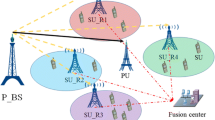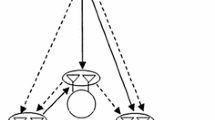Abstract
To allow secondary and primary concurrent transmissions achieving optimal spectrum utilization in cognitive radio networks (CRNs), this paper proposes an innovative distributed cooperative spectrum sensing methodology using adaptive sensing bandwidth entitled distributed adaptive cooperative bandwidth spectrum sensing (DACB-SS) scheme when multiple secondary users (SUs) use part of the bandwidth to collaboratively perform spectrum sensing throughout the whole frame to detect the primary user (PU)'s reappearance in time. The SU’s spectrum efficiency is maximized by jointly optimizing the sensing bandwidth proportion, the number of cooperative SUs, and the detection probability, subject to the constraints on the SUs’ interference and the false alarm probability. A gripping slant of DACB-SS regime is provided to maintain overall maximum spectral efficiency. Another contribution of DACB-SS algorithm is the benefit to make great improvement on the sum capacity to obtain better performance of spectrum coexistence. Simulation results illustrate that the proposed analytical model investigates characteristic changes of the spectrum usage affected by the outage probability of PR and the coexisting secondary transmission bandwidth in terms of overall spectral efficiency as well as the outage capacity which can be characterized by the outage probability of SR and the interference from ST to PR in multiuser multiple-input multiple-output broadcast channel (MU-MIMO-BC). Besides, the sum capacity is impacted by channel gains, primary transmit power and secondary transmit power in Gaussian cognitive inference channel (G-CIFC).


















Similar content being viewed by others
References
Lee, S., & Kim, S. L. (2011). Optimization of time-domain spectrum sensing for cognitive radio systems. IEEE Transactions on Vehicular Technology, 60(4), 1937–1943.
Soltanmohammadi, E., Orooji, M., & Naraghi, P. M. (2013). Improving the sensing-throughput tradeoff forcognitive radios in rayleigh fading channels. IEEE Transactions on Vehicular Technology, 62(5), 2118–2130.
Caire, G., & Shamai, S. (2003). On the achievable throughput of a multiantenna Gaussian broadcast channel. IEEE Transactions on Information Theory, 49(7), 1691–1706.
Yu, H. G., Tang, W. B., & Li, S. Q. (2011). Optimization of cooperative spectrum sensing with sensing user selection in cognitive radio networks. EURASIP Journal on Wireless Communications and Networking, 10(12), 1–8.
Jeong, S. S., Jeon, W. S., & Jeong, D. G. (2009). Collaborative spectrum sensing for multiuser cognitive radio systems. IEEE Transactions on Vehicular Technology, 58(5), 2564–2569.
Wu, S. H., Yang, C. Y., & Huang, D. H. T. (2010). Cooperative sensing of wideband cognitive radio: A multiple-hypothesis-testing approach. IEEE Transactions on Vehicular Technology, 59(4), 1835–1846.
Oh, D. C., & Lee, Y. H. (2010). Cooperative spectrum sensing with imperfect feedback channel in the cognitive radio systems. International Journal of Communication Systems, 23, 763–779. https://doi.org/10.1002/dac.1129
Fang, S., Berber, S. M., & Swain, A. K. (2010). Energy distribution-aware clustering algorithm for dense wireless sensor networks. International Journal of Communication Systems, 23, 1223–1251. https://doi.org/10.1002/dac.1103
Wang, H., & Noh, G. (2010). Dongkyn kim, Sungtae kim, and Daesik Hong, “Advanced Sensing Techniques of Energy Detection in Cognitive Radios.” Journal of Communications and networks, 12(1), 21–24.
Hamdi, K., Zhang, W. & Letaief, K. B. (2007). Power control in cognitive radio systems based on spectrum sensing side information. In IEEE International Conference on Communications, (pp. 5161–5165)
Liu, X., Jia, M., & Gu, X. (2013). Optimal periodic cooperative spectrum sensing based on weight fusion in cognitive radio networks. Sensors, 13(4), 5251–5272.
Lee, W., Cho, D.-H. (2008) Sensing optimization considering sensing capability of cognitive terminal in cognitive radio system. In 2008 IEEE Xplore, (pp. 1–6).
Huang, C. H., & Chen, K. C. (2011). Dual-observation time-division spectrum sensing for cognitive radios. IEEE Transactions on Vehicular Technology, 60(8), 3712–3725.
Li, H., (2010) Cooperative spectrum sensing via belief propagation in spectrum-heterogeneous cognitive radio systems. In WCNC (pp. 1–6)
Qihui, Wu., Ding, G., Wang, J., & Yao, Y.-D. (2013). Spatial-temporal opportunity detection for spectrum-heterogeneous cognitive radio networks: Two-dimensional sensing. IEEE Transactions on Wireless Communications, 12(2), 516–526.
Ding, G., Wang, J., Qihui, Wu., Song, F., & Chen, Y. (2013). Spectrum sensing in opportunity-heterogeneous cognitive sensor networks: How to cooperate? IEEE Sensors Journal, 13(11), 4247–4255.
Maleki, S., Chepuri, S. P., & Leus, G. (2013). Optimization of hard fusion based spectrum sensing for energy-constrained cognitive radio networks. Physical Communication, 9(12), 193–198.
Rini, S., Tuninetti, D., & Devroye, N. (2012). Inner and outer bounds for the Gaussian cognitive interference channel and new capacity results. IEEE Transactions on Information Theory, 58(2), 820–848.
Sung, K. W., Kim, S. L., & Zander, J. (2010). Temporal spectrum sharing based on primary user activity prediction. IEEE Transactions on Wireless Communications, 9(12), 3848–3855.
Liu, X., Jia, M., & Gu, X. (2013). Joint optimal sensing threshold and subcarrier power allocation in wideband cognitive radio for minimising interference to primary user. China Communications, 10(11), 70–80.
Liu, X., Kun-qi, C., & Jun-hua, Y. (2016). A novel weighed cooperative bandwidth spectrum sensing for spectrum occupancy of cognitive radio network. Journal of Central South University, 23, 1709–1718.
Cheng, S. M., Ao, W. C., & Chen, K. C. (2011). Efficiency of a cognitive radio link with opportunistic interference mitigation. IEEE Transactions on Wireless Communications, 10(6), 1715–1720.
Wang, S., Huang, F., Yuan, M., & Du, S. (2012). Resource allocation for multiuser cognitive OFDM networks with proportional rate constraints. International Journal of Communication Systems, 25, 254–269.
Ye, D. & Wang, Y.-M. (2009). A Setting Method and Performance Evaluation of Adaptive Sensing Threshold Based on Power Detection of the Primary User. In The 5th International Conference on Wireless Communications Networking and Mobile Computing, WiCOM 2009, (pp. 1–4), Sep 24–26.
Choi, H.-H., Jang, K. & Cheong, Y. (2008). Adaptive sensing threshold control based on transmission power in cognitive radio systems. In 2008 IEEE Xplore.
Wang, H., Ko, K., & Woo, C. (2012). Maximized achievable rate of SINR-measurement-based spectrum sharing with binary feedback. International Journal of Communication Systems, 25, 404–413. https://doi.org/10.1002/dac.1269
Devroye, N., Mitran, P., & Tarokh, V. (2006). Achievable rates in cognitive radio channels. IEEE Transactions on Information Theory, 52(5), 1813–1827.
Sohn, I., Andrews, J. G., & Lee, K. B. (2010). MIMO broadcast channels with spatial heterogeneity. IEEE Transactions on Wireless Communications, 9(8), 2449–2454.
Lien, S.-Y., Lin, Y.-Y., & Chen, K.-C. (2011). Cognitive and Game-Theoretical Radio Resource Management for Autonomous Femtocells with QoS Guarantees. IEEE Transactions on Wireless Communications, 10(7), 2196–2206.
León, O., Hernández-Serrano, J., & Soriano, M. (2010). Securing cognitive radio networks. International Journal of Communication Systems, 23, 633–652. https://doi.org/10.1002/dac.1102
Author information
Authors and Affiliations
Corresponding author
Additional information
Publisher's Note
Springer Nature remains neutral with regard to jurisdictional claims in published maps and institutional affiliations.
Appendix 1
Appendix 1
Proof of Theorem 3.2.
The first-order and second-order partial derivation details of the objective function of (10) can be computed as in (45) and (46), respectively.
Since \(A_{1} > 0\),\(A_{2} > 0\),\(A_{3} > 0\) and \(0 < Q(x) < 1\), from (45) we have
which indicates that there is \(a_{0} \left( N \right) \in \left[ {0,\varphi \left( N \right)} \right]\) that makes \(\nabla_{a} \eta \left( {a_{0} N),N} \right) = 0\),\(a_{0} \left( N \right)\) is an extreme point of \(\eta \left( {a,N} \right).\)
Then we will prove that is also a maximal point. As \(P_{f} = Q\left( {A_{0} + A_{1} \sqrt {aH\left( N \right)} } \right) \le \varepsilon \le 0.5\), we have
\(A_{0} + A_{1} \sqrt {aH\left( N \right)} > 0,\) and thus from (46) we have \(\nabla_{a}^{2} \eta \left( {a,N} \right) < 0\),indicating that \(\eta \left( {a,N} \right)\) is a convex function. Hence,\(a_{0} \left( N \right)\) is the maximal point of \(\eta \left( {a,N} \right)\).
Rights and permissions
About this article
Cite this article
Ye, D. Distributed Adaptive Cooperative Bandwidth Spectrum Sensing for Cognitive MIMO Radios. Wireless Pers Commun 119, 1869–1897 (2021). https://doi.org/10.1007/s11277-021-08310-9
Accepted:
Published:
Issue Date:
DOI: https://doi.org/10.1007/s11277-021-08310-9




